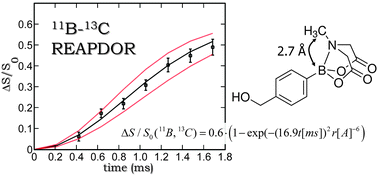Distance measurements between boron and carbon at natural abundance using magic angle spinning REAPDOR NMR and a universal curve†
Abstract
The rotational echo adiabatic passage double resonance (REAPDOR)

* Corresponding authors
a
School of Chemistry, Raymond and Beverly Sackler Faculty of Exact Sciences, Tel Aviv University, Ramat Aviv, Tel Aviv, Israel
E-mail:
amirgo@post.tau.ac.il
Fax: +972-36409293
Tel: +972-36408437
The rotational echo adiabatic passage double resonance (REAPDOR)

 Please wait while we load your content...
Something went wrong. Try again?
Please wait while we load your content...
Something went wrong. Try again?
E. Nimerovsky and A. Goldbourt, Phys. Chem. Chem. Phys., 2012, 14, 13437 DOI: 10.1039/C2CP41851G
To request permission to reproduce material from this article, please go to the Copyright Clearance Center request page.
If you are an author contributing to an RSC publication, you do not need to request permission provided correct acknowledgement is given.
If you are the author of this article, you do not need to request permission to reproduce figures and diagrams provided correct acknowledgement is given. If you want to reproduce the whole article in a third-party publication (excluding your thesis/dissertation for which permission is not required) please go to the Copyright Clearance Center request page.
Read more about how to correctly acknowledge RSC content.
 Fetching data from CrossRef.
Fetching data from CrossRef.
This may take some time to load.
Loading related content
